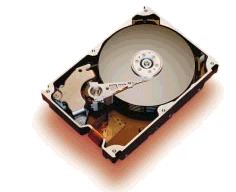| Western Digital Expert
by John Reynolds |
||||
|
Next to the newest CPU, gobs of memory, and a fast 3D board, a good hard drive is a gamer's best friend. Used for storing a plethora of information that can run a gamut as wide as Word files and MP3s to AVIs and game installs, fixed drives have grown in their storage capacities by leaps and bounds during the past two or three years. I not-so-fondly recall my first hard drive, a 100 megabyte IDE Conner, a storage device that is pitiably slow by today's standards and too small to even install most operating systems on. May it rest in pieces. Fortunately, technology marches on and in the neverending effort to remain competitive-like everything else in today's PC market-hard drives keep getting faster and faster. Case in point is Western Digital's Expert lineup. Arriving in two sizes, 9gb or 18gb, the Expert drives feature a relatively new technology for EIDE hard drives, and that's a spindle rotation speed of 7200rpm (rotations per minute). A mainstay of SCSI drives, this high-speed rotation of the drive's platters allows for faster seek, or access, times, which in turn will certainly help games run more smoothly as your system swaps to and from virtual memory. The Experts also come with a whopping 2mb of buffers, which is huge considering that Caviars shipped not too long ago with only 128k and that the highly-touted Seagate Cheetah SCSI drives sport only 1mg of buffers. Yet beyond the already noteworthy features of 7200rpm and 2mb buffers, the Experts come with what Western Digital calls Data Lifeguard. Straight from WD's website (www.westerndigital.com), "Data Lifeguard is a set of failure prevention features that builds on the initial failure prediction concept introduced in S.M.A.R.T. (Self-Monitoring, Analysis, and Reporting Technology), designed to advise the end user about possible hard drive failure. Data Lifeguard takes S.M.A.R.T. implementation one step further, as it automatically performs daily data protection by scanning, identifying and repairing potentially bad sectors before data loss occurs." Moreover, this feature is designed to operate only during idle times, automatically stopping once the drive receives a disk I/O request and only resuming again once idle. |
 Installing the Expert is a simple affair. I opened my test system's case, slid the Expert into an empty slot in the drive cage, attached the power and ribbon cables (red cabling facing toward each other), the latter to the motherboard's primary IDE controller, then powered up the system and hit the DEL key to enter the CMOS settings. Once there, I changed the Primary Master's former setting to Auto, which allows the motherboard to detect the drive's settings on its own. This Auto-detect feature in standard CMOS setups has become commonplace and was definitely a welcome addition several years ago compared to manually entering a hard drive's size, number of cylinders, its mode, or interface, and so on. A quick boot from a floppy diskette that held the necessary utilities of Fdisk.exe and Format.com (found these days in your Windows/Command folder), and this drive was ready for the big-time. Or so I thought. . . . The standard IDE controller found on today's motherboards is what's known as the ATA/33, or EIDE (Enhanced IDE), interface. The AT Attachment (ATA) interface is currently supported by Intel's dominant LX- and BX-chipsets, with ATA/33 (the /33 designates a maximum burst, or throughput, rate of 33mb) expected to be eventually phased out by the ATA/66 support in the upcoming 820, or Camino, chipset. With a nod toward this future improvement in drive technology, Western Digital has incorporated ATA/66 support into their Expert drives. Unfortunately, for some inexplicable reason they ship the drives with ATA/66 support enabled, forcing users to download the WDATA66 utility and disable this, lest they actually want to experience potential instability and sporadic lockups. Go to Page Two: Installation
|
|||
|
Copyright © 1997 - 2000 COMBATSIM.COM, INC. All Rights Reserved. Last Updated June 30th, 1999 |
||||
